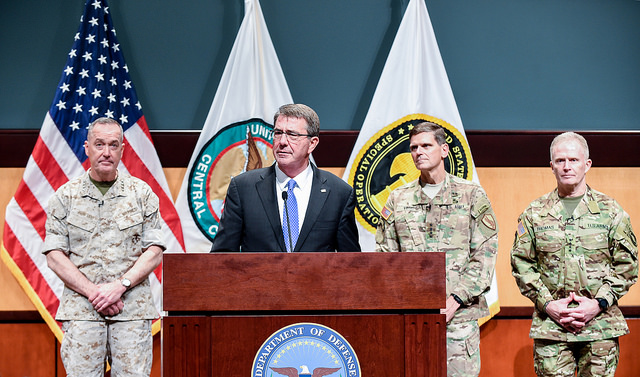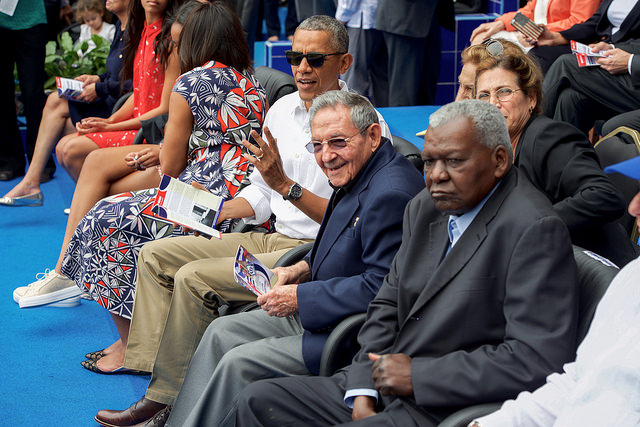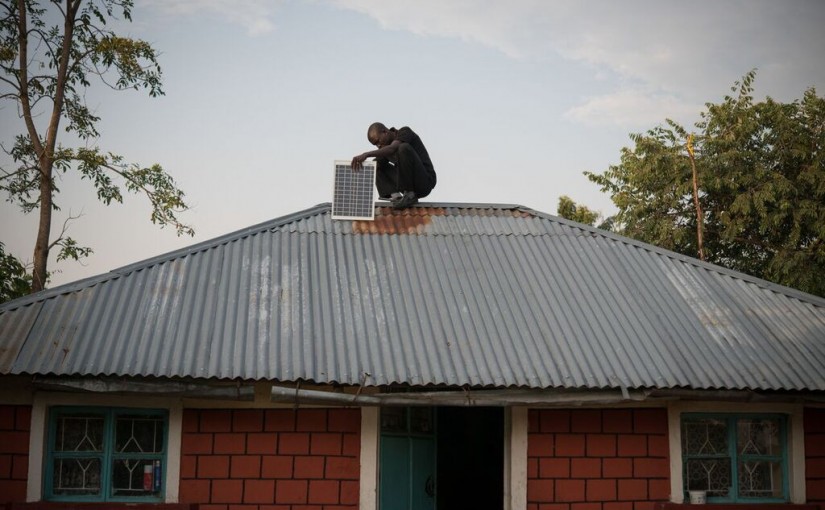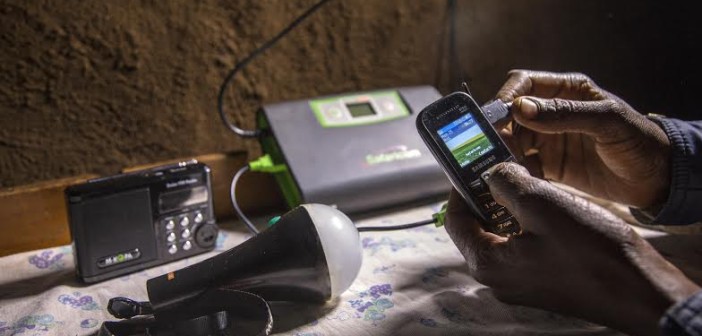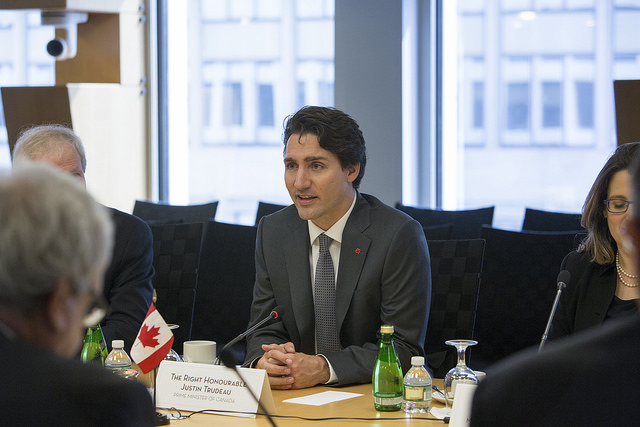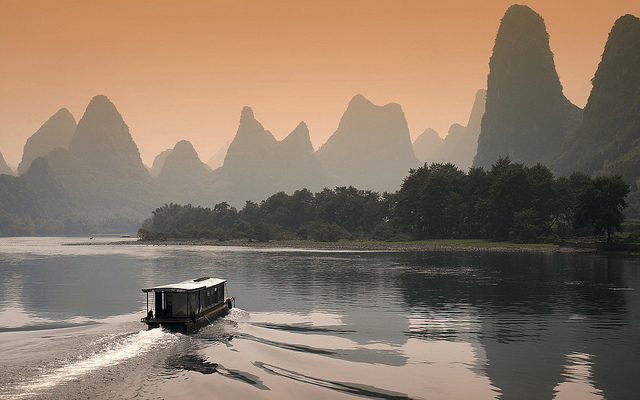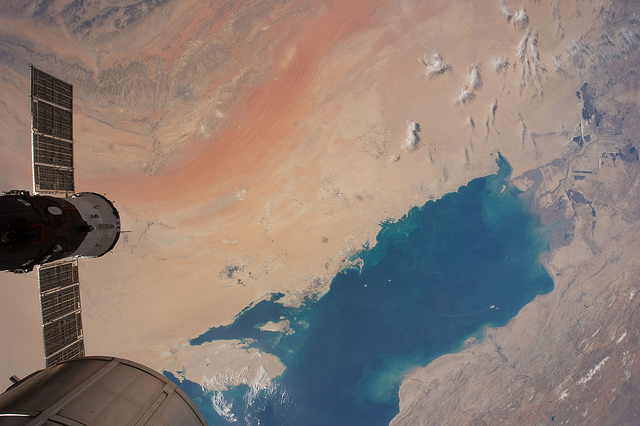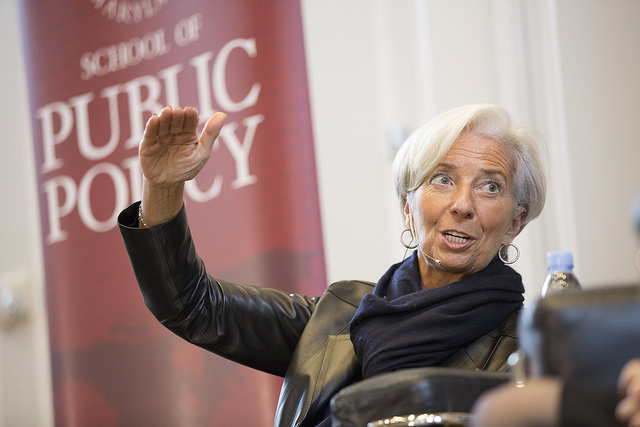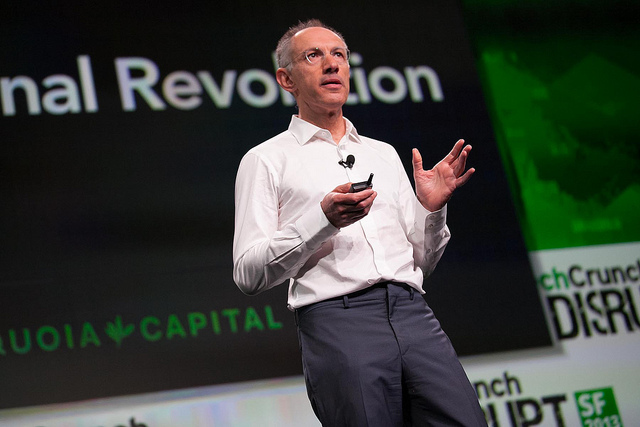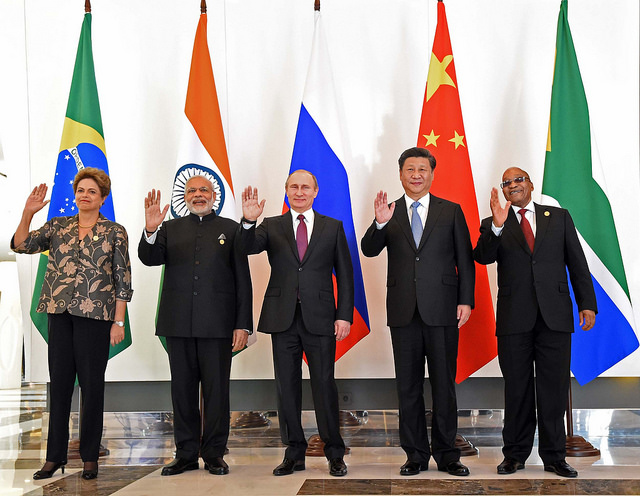by David Parmer
“Let me start by explaining what I mean by emerging markets. This is a group of about 30-50 countries that are in a transition phase—not too rich, not too poor, and not too closed to foreign capital, with regulatory and financial systems that have yet to fully mature.”
IMF Managing Director Christine Lagarde talked emerging markets and “a new economic reality” during a speech on February 4, 2016 at the University of Maryland. Lagarde, who has recently been re-appointed in an uncontested election at the IMF will start her second term on July 5, 2016. During her tenure the world has seen the slowdown of the Chinese economy, the Greek meltdown, and now the rock-bottom price of oil.
Here we present the full text of Ms. Lagarde’s February 4, 2016 speech.
Good morning. Thank you, Dean Robert Orr for your very kind introduction.
And thank you to you—students and faculty—for welcoming me here today. I would like to recognize my friend, Ambassador Susan Schwab, who will join me for a conversation after my remarks.
I am absolutely delighted to be hosted by one of the finest public policy schools in the world. This is a place where future leaders acquire essential skills, where future policymakers develop ideas and tools to address the pressing issues of the 21st century.
Today I would like to share with you my views on a key 21stcentury issue—the growing importance of emerging market economies. And by growing importance, I mean for the global economy, for advanced countries like the United States, and for you and me personally.
To get started on this topic, let us consider all the possible connections with emerging markets in the first 30 minutes of your day:
• Let’s assume it is 7:00 am, and the alarm goes off on your Chinese-made smartphone. (Ok, let’s say it is 9:00 am—perhaps you have had a long night behind you!)
• On the way to the shower, you send a WhatsApp message to your TA. WhatsApp, of course, was co-founded by a Ukrainian computer engineer.
• A few minutes later, your roommate has also woken up. With a third of UMD graduate students being international students, there is a good chance that she may be facetiming with relatives in India.
• At 9:15 am, you are facing a really tough choice—between strong coffee from Kenya and a milder variety out of Colombia.
• You switch on your Bluetooth speaker—made in Malaysia—to listen to the news.
• Overnight, global stock markets were rattled by the latest Chinese economic data—which has put a dent in your mom’s 401(k) savings plan, and you worry about Spring Break in Mexico.
• Luckily, as you head out to a field trip in a Zip Car made in Korea, you realize that low oil demand and strong supply from emerging markets have also brought down gas prices!
As you contemplate these first minutes of your day, you realize that the center of economic gravity has been slowly shifting. Yes, the United States is still the most important economy in the world, but New York, Chicago, and L.A. have gotten company, from Beijing to Brasilia, from Moscow to Mumbai, and from Jakarta to Johannesburg.
Emerging and developing economies are home to 85 percent of the world’s population—6 billion people. These 85 percent matter to the global economy more than ever, and they matter to you more than ever—because of strong linkages through trade, finance, economics, geopolitics, and personal connections that you experience every day.
A New Partnership for Growth
As a group, emerging and developing economies now account for almost 60 percent of global GDP, up from just under half only a decade ago.1 They contributed more than 80 percent of global growth since the 2008 financial crisis, helping to save many jobs in advanced economies, too. And they have been the main driver behind the significant reduction in global poverty.2
China alone has lifted more than 600 million people out of poverty over the past three decades.
After years of success, however, emerging markets—as a group—are now facing a new, harsh reality. Growth rates are down, capital flows have reversed, and medium-term prospects have deteriorated sharply. Last year, for example, emerging markets saw an estimated $531 billion in net capital outflows, compared with $48 billion in net inflows in 2014.3
In the short term, the softening of growth, the scale of capital outflows, as well as the recent stock market declines are cause for concern.
Furthermore, on current IMF forecasts, emerging and developing economies will converge to advanced economy income levels at less than two-thirds the pace we had predicted just a decade ago.
This means that millions of poor people are finding it more difficult to get ahead. And members of the newly created middle classes are finding their expectations unfulfilled.
This is bad not only for emerging markets themselves, but also for the advanced world that has come to rely on emerging markets as destinations for investment and as customers for its products.
It also carries with it the risk of rising inequality, protectionism, and populism.
This is why we need what I call a new “partnership for growth”. Both emerging and advanced economies need to play their part to promote faster and more sustainable convergence.
With this in mind, I would like to address three questions:
• First, what are the key challenges facing emerging markets and what are the interlinkages between emerging and advanced economies?
• Second, how can we forge a new partnership for growth?
• And third, what can be done to support this process—including by institutions like the IMF?
1. Key Challenges and Spillovers
Let me start by explaining what I mean by emerging markets. This is a group of about 30-50 countries that are in a transition phase—not too rich, not too poor, and not too closed to foreign capital, with regulatory and financial systems that have yet to fully mature.
Let me also emphasize that these countries are incredibly diverse—culturally, geographically, and even economically. Right now, for example, Brazil and Russia are in recession, while India and Mexico are enjoying robust growth. So it would be a mistake to think of these countries as a homogenous bloc.
At the same time, all these countries are eager to catch up with their richer peers. As I explained, however, the current difficult economic context makes catching up much harder—which brings me to the key challenges.
Challenges
First—China’s growth transition. China has embarked on an ambitious rebalancing of its economy—from industry to services, from exports to domestic markets, and from investment to consumption. It is also moving towards a more market-oriented financial system.
These reforms are a necessary process that, in the long run, will lead to more sustainable growth and benefit both China and the world.
In the short run, however, it will lead to slower growth, and this slowdown creates spillover effects—through trade and lower demand for commodities, and amplified by financial markets.
Second—declining commodity prices. Oil and metals prices have fallen by around two-thirds from their most recent peaks, and are likely to stay low for quite some time. As a result, many commodity-exporting emerging economies are under severe stress, and some currencies have already seen very large depreciations.
Third—asynchronous monetary policies. The Federal Reserve has raised interest rates in response to a strengthening U.S economy, while other advanced economies have not raised interest rates, or have gone in the opposite direction.
This has contributed to a rise of the U.S. dollar—putting considerable strain on those emerging market companies that took on large amounts of US dollar-denominated debt, especially in the energy sector.4
This means that anybody who holds an exposure to such companies, whether banks or governments, may be vulnerable to losses.
In addition to these challenges, the emerging world is also facing increasing geopolitical and environmental risks. Think of the Syrian refugee crisis that is directly affecting countries such as Turkey, Lebanon, and Jordan, which are hosting millions of displaced people.
Think of the impact of climate change on food prices, political stability, and people’s health, particularly in Sub-Saharan Africa and southern Asia. By 2030 it is expected that more than 98 percent of deaths related to climate change will occur in developing countries.
Spillovers and Spillbacks
All this matters to advanced economies—because of what we at the IMF call spillovers and spillbacks. What does that mean?
It means a two-way street of unintended knock-on effects—with actions in one country spilling over to others, which in turn creates a negative feedback, or spillback effect, on the country that started the process. Emerging markets have reached a size where such effects are big enough to be noticed everywhere.
Let me give you some examples:
Financial spillovers. Last August, global financial markets were rattled by China’s announcement of a new exchange rate arrangement. And at the beginning of this year, another stock market plunge in Shanghai made global investors hit the “sell” button. More broadly, weaker corporate fundamentals in emerging markets can also trigger financial spillovers to the rest of the world.5 So, watch those balance sheets!
Trade spillovers. Global trade has slowed down dramatically in recent years, partly because of China’s economic slowdown. This matters to all of us—not only because trade has historically been a major driver of growth, jobs, and prosperity, but also because trade betweenemerging and advanced economies now exceeds trade among advanced economies.
Economic spillovers. Adding it all up, our estimates show that a slowdown of one percent in the emerging world would reduce growth in advanced countries by about 0.2 percentage points. This may not sound like much, but in fact would be a significant blow to those advanced countries that are already struggling with what I have called a “new mediocre” of low growth and high unemployment.
There are also environmental spillovers. Over the next 15 years, we may be looking at up to $90 trillion in global infrastructure investment, mostly in emerging and developing economies that will see a massive increase in urbanization.6
Just think about the risk if this investment is done in the wrong way—for example, if it locks in carbon-intensive energy and transportation structures in these mega-cities. This could radically affect the quality of life on the planet—for all of us.
So my message is: emerging and advanced economies depend on each other, and the world depends on their collaboration. How can the two sides do more to make it work?
2. It Takes Two to Grow: Mutual Responsibilities
The simple answer to the question is this: it takes two to grow. And this is my second topic. The idea is that strong policy actions by emerging and advanced economies can be a win-win for both. A win-win for the global economy.
So what can emerging market economies do?
Let us start with the immediate challenges. And let us focus here on commodity-exporting emerging economies that are facing increasing budget deficits and growing foreign-exchange pressures.
These countries could make their fiscal adjustment less painful—by upgrading the efficiency of spending, strengthening fiscal institutions, and increasing non-commodity revenues. At the same time, allowing for greater exchange rate flexibility can help many of them soften the impact of the adverse external shocks they are facing.
In many cases, emerging economies will also need to step up the use of so-called macroprudential tools to limit financial sector risks—either by monitoring the foreign currency debt that some of their major companies are carrying, or by limiting the fallout from the large credit expansion that many countries have gone through in recent years.
What can advanced economies do?
Faced with modest growth prospects, advanced economies need to continue to support demand through accommodative monetary policies. But they should use a more balanced policy mix. What do I mean by that?
For several years now, advanced economies have relied largely on monetary policy by keeping interest rates extremely low. This was crucial to help the recovery from the 2008 financial crisis.
But central banks cannot do it alone. Countries with budgetary room for maneuver should also use fiscal policy to stimulate their economies—for example, by funding much-needed upgrades of public infrastructure.
At the same time, the United States has a special responsibility as it normalizes its monetary policy—because this can be a source of global spillovers and spillbacks. So it is important that the Federal Reserve continue to do this in a prudent and well-communicated manner.
And what is it that both emerging and advanced economies can do?
There are no easy answers here. Both need to address the underlying economic issues that are fundamental to boost potential growth and promote the sustainable income convergence that I talked about earlier.
Let me highlight two priorities:
First, foster more and better innovation—by removing barriers to competition, cutting red tape, enhancing the mobility of labor, and investing more in education and research. This would unleash entrepreneurial energy and help attract private investment in ideas that are new, surprising, and useful.
This would also strengthen the role of public research institutions, such as the University of Maryland. Remember that all the technologies that make your phone “smart” have benefited from state funding—the internet, wireless networks, GPS, microelectronics, and touch screens.
Private companies like Apple put it all together—brilliantly—but they would not have had the incentives and financial muscle to do it all by themselves!
Second—facilitate a greater sharing of technologybetween the advanced economies and their emerging peers. This would, for example, require finding a better balance between intellectual property protection and technology dissemination.
Emerging economies would need to rethink their approach to patent protection. At the same time, we should ask whether ideas in advanced economies are, in some cases, too strongly protected. There has been an active global debate on these issues, including on pharmaceuticals and medical treatments.
Another way to facilitate the sharing of technology and know-how is foreign direct investment. FDI into emerging and developing economies, as a share of GDP, is now well below what it was in 2000-06. Our global forecasts predict it will fall even further by the end of the decade. So we need greater efforts to remove unnecessary barriers to FDI, and to replace hot money with longer-term investment.
Likewise, we need to promote technology sharing by promoting trade reforms. For at least three decades before the 2008 financial crisis, global trade regularly grew at twice the rate of the global economy. It is now expanding at, or below, the rate of the global economy. Aside from the China effect, this is because of the slowdown in trade liberalization in recent years.
So we need greater efforts to open up global trade systems and promote trade integration through regional and multilateral agreements.
Finally—both advanced and emerging market countries need to complete and implement the global regulatory reform agenda—which is essential to create a more resilient global financial system.
3. What Can Be Done Globally to Help?
This brings me to my final topic—what more can be done at the global level to support the efforts of emerging and advanced economies? And how can the IMF support this new partnership for growth?
From the point of view of emerging markets, the current international monetary system is less supportive than it should be. This is one area where I have called for a “global policy upgrade”.
What do I mean by international monetary system? I mean the rules and conventions that govern exchange rates, international capital movements, reserves, and official arrangements that allow countries to access liquidity in times of distress—the so-called global financial safety net.
This system also involves institutions designed to ensure that the rules and mechanisms are enforced. The IMF itself was established more than 70 years ago to promote the effective operation of this system. We do this by monitoring the economic and financial stability of our 188 members, by providing financial support in times of distress, and by offering world-class technical assistance and training.
Let me highlight two elements of the international monetary system where smart retooling could be helpful: (i) capital flows and (ii) the global safety net.
Safer capital flows
A stronger monetary system should include a framework for safer capital flows.
Capital flows have increased significantly over the past four decades. Between 1980 and 2007, for example, global capital flows increased more than 25-fold, compared with an eight-fold expansion in global trade.
The good news is that this has underpinned higher investment in many emerging economies that need foreign capital to finance their development. The bad news is that we have seen episodes of high capital flow volatility that can contribute to financial pressures in the emerging world and can—as I noted previously—“spillback” to the advanced economies.
There is now a growing recognition that the short-term nature and inherent volatility of global capital flows are problematic. What can be done?
Again, there are no easy answers here, but let me offer some preliminary thoughts on what could be done over the medium term. To my mind, countries would benefit from a shift towards more long-term, equity-based capital flows.
In source countries, for example, the supervisory framework could be adjusted to ensure that prudent levels of capital are held behind short-term debt-creating flows. In recipient countries, stronger macroprudential policies could help to make financial systems more resilient.
And in both emerging and advanced economies, it may be helpful to reconsider tax policies—which have a built-in bias towards debt, largely through interest deductibility.
Stronger global financial safety net
In addition to safer capital flows, a stronger international monetary system must include an adequate global financial safety net—to enable access to financial resources in times of crisis or distress.
What exactly is the safety net? It includes countries’ foreign-exchange reserves, currency arrangements—known as swap lines—between central banks, regional financial arrangements, and of course the IMF.
While the safety net has expanded in size and coverage since the 2008 financial crisis, it has also become more fragmented and asymmetric.
For example, many emerging economies do not have access to the existing swap lines between advanced country central banks. This is a challenge because emerging economies depend critically on advanced country currencies in their trade and finance.
It is not surprising, therefore, that many emerging economies have built up their own large safety buffers of foreign exchange reserves. Why is that a problem? Because it means that, for many years, capital was flowing “uphill”—from poorer emerging markets to richer advanced economies. This is counter-intuitive because the returns on capital should be higher in poorer countries.
A stronger safety net would help reduce the need for this kind of “self-insurance”. It would also free up capital for much-needed investments in the emerging world—in infrastructure, health, and education, for example.
So how can the safety net be strengthened? For example, one could think about strengthening and broadening global precautionary financing instruments that work for everyone. One could also increase the size of the safety net. Over the next few months, the IMF will be considering with our members these and other issues related to the international monetary system.
The role of the IMF
Which brings me to my final point today: the role of the IMF. I am pleased to tell you that our role has been strengthened by the approval by our membership of a set of Quota and Governance Reforms—which actually came into effect last week. Why is this so important?
First, it places the institution on a more sustainable footing financially—doubling our permanent resources—and it strengthens our ability to respond quickly to our members’ needs.
Second, it also enhances the representation of dynamic emerging and developing economies in the IMF’s governance structure. For the first time in history, emerging market countries like Brazil, China, India, and Russia are now among the 10 largest shareholders of the Fund.
The bottom line is that today’s IMF more accurately reflects the dynamics of the 21st century’s global economy—including the role of emerging markets. It also bolsters the IMF’s ability to bring emerging and advanced economies together in this new partnership for growth.
4. Conclusion: a new economic reality
So, that is what I wanted to say to you today. A new economic reality has slowly emerged as countries have developed and grown richer. And now that some of these countries experience difficulties after many years of strong growth, we are affected by it, too. This is not something to fear, but it does require us to be aware and think a bit differently, a bit more multilaterally.
I have spoken about what emerging and advanced economies can do. What about you? What can you do?
As future leaders and policymakers, you will have the opportunity to play your part—for example—by promoting climate change awareness, highlighting the dangers of excessive inequality, and insisting on the highest standards of ethical behavior in all walks of life.
As President John F. Kennedy once said:
“Change is the law of life, and those who look only to the past or present are certain to miss the future.”
My message today is that the role of emerging and developing economies is a defining feature of the 21stcentury—and of the world in which you and your children will live. By forging a new partnership, by strengthening what I have called a “new multilateralism”, we can create a more prosperous and more peaceful future for everybody.
Thank you.
Full Text of Speech: http://www.imf.org/external/np/speeches/2016/020416.htm
Photo: IMF via flickr
 日本語
日本語 English
English 中国語
中国語